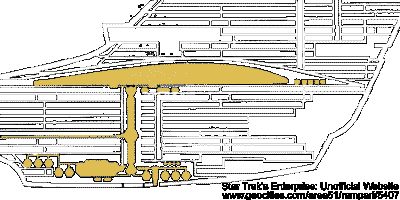
Matter/Antimatter Reaction System
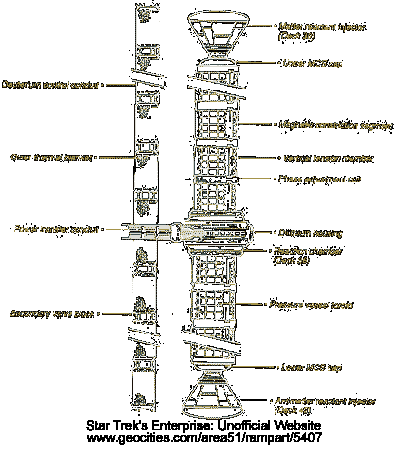
Matter/Antimatter Reaction Assembly
REACTANT INJECTORS
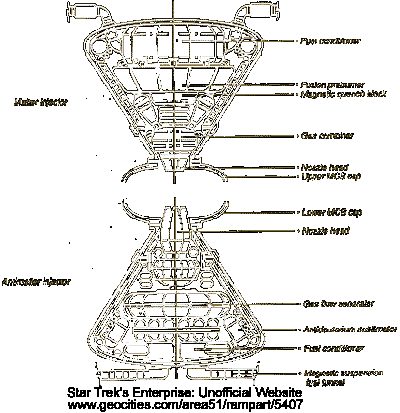
Reactant Injectors
MAGNETIC CONSTRICTION SEGMENTS
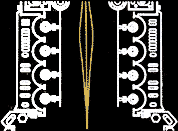
Magnetic Constriction Segments
MATTER/ANTIMATTER REACTION CHAMBER
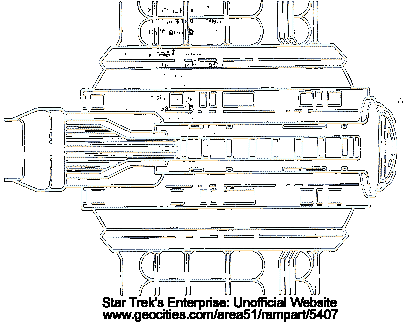
Matter/Antimatter Chamber
THE ROLE OF DILITHIUM
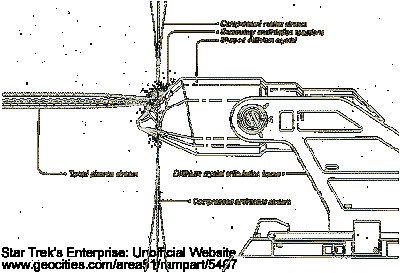
Matter/Antimatter Chamber
M/ARC POWER GENERATION
- From a cold condition, the total em temperature and pressure is brought up to 2,500,000K using a combination of energy inputs from the electro plasma system (EPS) and; the MRI, and a "squeeze" from the upper magnetic constric- tors.
- The first minute amounts of antimatter are injected; from below by the ARI. The lower MCS array squeezes the antimatter stream and matches its aim with the MRI above, so that both streams land at exactly the same XYZ coordinates within the M/ARC. The largest reaction cross-section radius is 9.3 cm, the smallest 2.1 cm. The stream cross-sections of the upper and lower MCS can vary, depending on the power level setting.
- There are two distinct reaction modes. The first involves the generation of high levels of energy channeled to the electro plasma system, much like a standard fusion reaction, to provide raw energy for ship function while at sublight. In the DCAF, the crystal alignment cradle positions the dilithium so that the edge of two facets lies parallel to the matter/antimatter streams, coincident with the core's XYZ, O, 0, 125, where 125 is the reactant cross section radius. The reaction is mediated by the dilithium, forcing the upper limit of the resulting EM frequencies down, below 1020 hertz, and the lower limit up, above 10" hertz.
- The second mode makes full use of dilithium's ability cause a partial suspension of the reaction, creating the critical pulse frequency to be sent to the warp engine nacelles. In this mode the XYZ coordinates are driven by the three-axis adjustments made by the DCAF and place the exact mathematical collision point 20 angstroms above the upper dilithium crystal facet. The optimum frequency range is continuously tuned for specific warp factors and fractional warp factors. Regardless of the mode employed, the annihilation effect takes place at chamber centerpoint. The M/A, ratio is stabilized at 25:1, and the engine is considered to be at "idle.
- The engine pressure is slowy brought up to 72 000 kilopascals, roughly 715 times atmospheric pressure, and the normal operating temperature at the reaction site is 2 x 10E12 K. The MRI and ARI nozzles are opened to permit more reactants to fill the vessel. The ratio is adjusted to 10:1 tor power generation. This is also the base ratio for making Warp 1 entry. The relative proportions of matter and antimatter change as warp factors rise until Warp 8, where the ratio becomes 1:1. Higher warp factors require greater amounts of reactants, but no change in ratio.
- From a cold condition, the total em temperature and pressure is brought up to 2,500,000K using a combination of energy inputs from the electro plasma system (EPS) and; the MRI, and a "squeeze" from the upper magnetic constric- tors.
POWER TRANSFER CONDUITS

Port and Starboard Warp Power Transfer Conduits
|
Copyright © 1998 Tan Ngo-Dang Contact: tangowebmedia@sympatico.ca URL: http://www.oocities.org/area51/rampart/5407/warp02.htm |
Created on 02/26/98 Updated on 05/30/98 Page status: final |